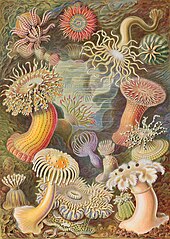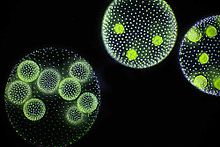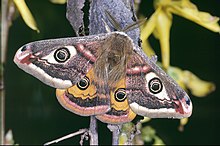Symmetry in biology

Symmetry in biology is the balanced distribution of duplicate body parts or shapes within the body of an organism. In nature and biology, symmetry is always approximate. For example, plant leaves – while considered symmetrical – rarely match up exactly when folded in half. Symmetry creates a class of patterns in nature, where the near-repetition of the pattern element is by reflection or rotation.
The body plans of most multicellular organisms exhibit some form of symmetry, whether radial, bilateral, or spherical. A small minority, notably among the sponges, exhibit no symmetry (i.e., are asymmetric). Symmetry was once important in animal taxonomy; the Radiata, animals with radial symmetry, formed one of the four branches of Georges Cuvier's classification of the animal kingdom.
Radial symmetry

Radially symmetric organisms resemble a pie where several cutting planes produce roughly identical pieces. Such an organism exhibits no left or right sides. They have a top and a bottom surface, or a front and a back.
Symmetry has been important historically in the taxonomy of animals; Georges Cuvier classified animals with radial symmetry in the taxon Radiata (Zoophytes),[1][2] which is now generally accepted to be a polyphyletic assemblage of different phyla of the Animal kingdom.[3] Most radially symmetric animals are symmetrical about an axis extending from the center of the oral surface, which contains the mouth, to the center of the opposite, aboral, end. Radial symmetry is especially suitable for sessile animals such as the sea anemone, floating animals such as jellyfish, and slow moving organisms such as starfish. Animals in the phyla Cnidaria and Echinodermata are radially symmetric,[4] although many sea anemones and some corals have bilateral symmetry defined by a single structure, the siphonoglyph.[5]

Many flowers are radially symmetric or actinomorphic. Roughly identical flower parts – petals, sepals, and stamens – occur at regular intervals around the axis of the flower, which is often the female part, with the carpel, style and stigma.[6]

Many viruses have radial symmetries, their coats being composed of a relatively small number of protein molecules arranged in a regular pattern to form polyhedrons, spheres, or ovoids. Most are icosahedrons.[7]
Special forms of radial symmetry
Tetramerism is a variant of radial symmetry found in jellyfish, which have four canals in an otherwise radial body plan.

Pentamerism (also called pentaradial and pentagonal symmetry) means the organism is in five parts around a central axis, 72° apart. Among animals, only the echinoderms such as sea stars, sea urchins, and sea lilies are pentamerous as adults, with five arms arranged around the mouth. Being bilaterian animals, however, they initially develop with mirror symmetry as larvae, then gain pentaradial symmetry later.[8]
Flowering plants show fivefold symmetry in many flowers and in various fruits. This is well seen in the arrangement of the five carpels (the botanical fruits containing the seeds) in an apple cut transversely.
Hexamerism is found in the corals and sea anemones (class Anthozoa) which are divided into two groups based on their symmetry. The most common corals in the subclass Hexacorallia have a hexameric body plan; their polyps have sixfold internal symmetry and the number of their tentacles is a multiple of six.
Octamerism is found in corals of the subclass Octocorallia. These have polyps with eight tentacles and octameric radial symmetry. The octopus, however, has bilateral symmetry, despite its eight arms.
Spherical symmetry

Spherical symmetry occurs in an organism if it is able to be cut into two identical halves through any cut that runs through the organism's center. Organisms which show approximate spherical symmetry include the freshwater green alga Volvox.[4]
Bilateral symmetry
In bilateral symmetry (also called plane symmetry), only one plane, called the sagittal plane, divides an organism into roughly mirror image halves. Thus there is approximate reflection symmetry. Internal organs are however not necessarily symmetric.

Animals that are bilaterally symmetric have mirror symmetry in the sagittal plane, which divides the body vertically into left and right halves, with one of each sense organ and limb group on either side. At least 99% of animals are bilaterally symmetric, including humans,[9][10][11] where facial symmetry influences people's judgements of attractiveness.[12]
When an organism normally moves in one direction, it inevitably has a front or head end. This end encounters the environment before the rest of the body as the organism moves along, so sensory organs such as eyes tend to be clustered there, and similarly it is the likely site for a mouth as food is encountered.[11] A distinct head, with sense organs connected to a central nervous system, therefore (on this view) tends to develop (cephalization). Given a direction of travel which creates a front/back difference, and gravity which creates a dorsal/ventral difference, left and right are unavoidably distinguished, so a bilaterally symmetric body plan is widespread and found in most animal phyla.[11][13] Bilateral symmetry also permits streamlining to reduce drag, and on a traditional view in zoology facilitates locomotion.[11] However, in the Cnidaria, different symmetries exist, and bilateral symmetry is not necessarily aligned with the direction of locomotion, so another mechanism such as internal transport may be needed to explain the origin of bilateral symmetry in animals.[11][14]

The phylum Echinodermata, which includes starfish, sea urchins and sand dollars, is unique among animals in having bilateral symmetry at the larval stage, but pentamerism (fivefold symmetry) as adults.[15]
Bilateral symmetry is not easily broken. In experiments using the fruit fly, Drosophila, in contrast to other traits (where laboratory selection experiments always yield a change), right- or left-sidedness in eye size, or eye facet number, wing-folding behavior (left over right) show a lack of response.[16]
Females of some species select for symmetry, presumed by biologists to be a mark (technically a "cue") of fitness. Female barn swallows, a species where adults have long tail streamers, prefer to mate with males that have the most symmetrical tails.[17]

Flowers in some families of flowering plants, such as the orchid and pea families, and also most of the figwort family,[18] are bilaterally symmetric (zygomorphic).[19]
Biradial symmetry
Biradial symmetry is a combination of radial and bilateral symmetry, as in the ctenophores. Here, the body components are arranged with similar parts on either side of a central axis, and each of the four sides of the body is identical to the opposite side but different from the adjacent side. This may represent a stage in the evolution of bilateral symmetry "from a presumably radially symmetrical ancestor."[14]
Asymmetry
Not all animals are symmetric. Many members of the phylum Porifera (sponges) have no symmetry, though some are radially symmetric.[20]
It is normal for essentially symmetric animals to show some measure of asymmetry. Usually in humans the left brain is structured differently to the right;[21] the heart is positioned towards the left;[22] and the right hand functions better than the left hand.[23] The scale-eating cichlid Perissodus microlepis develops left or right asymmetries in their mouths and jaws that allow them to be more effective when removing scales from the left or right flank of their prey.[24]
The approximately 400 species of flatfish also lack symmetry as adults, though the larvae are bilaterally symmetrical. Adult flatfish rest on one side, and the eye that was on that side has migrated round to the other (top) side of the body.[25]
See also
Biological structures
- Standard anatomical position
- Anatomical terms of motion
- Anatomical terms of muscle
- Anatomical terms of bone
- Anatomical terms of neuroanatomy
- Glossary of botanical terms
- Glossary of plant morphology
- Glossary of leaf morphology
- Glossary of entomology terms
- Plant morphology
Terms of orientation
- Handedness
- Laterality
- Proper right and proper left
- Reflection symmetry
- Sinistral and dextral
- Direction (disambiguation)
- Symmetry (disambiguation)
References
Citations
- ^ Waggoner, Ben M. "Georges Cuvier (1769-1832)". UCMP Berkeley. Retrieved 8 March 2018.
Cuvier's insistence on the functional integration of organisms led him to classify animals into four "branches," or embranchements: Vertebrata, Articulata (arthropods and segmented worms), Mollusca (which at the time meant all other soft, bilaterally symmetrical invertebrates), and Radiata (cnidarians and echinoderms).
- ^ Cuvier, Georges; Griffith, Edward; Pidgeon, Edward (1834). The Mollusca and Radiata: Arranged by the Baron Cuvier, with Supplementary Additions to Each Order. Whittaker and Company. pp. 435–.
- ^ Hadzi, J. (1963). The Evolution of the Metazoa. Macmillan. pp. 56–57. ISBN 0080100791.
- ^ a b Chandra, Girish. "Symmetry". IAS. Retrieved 14 June 2014.
- ^ Finnerty, J.R. (2003). "The origins of axial patterning in the metazoa: How old is bilateral symmetry?". The International journal of developmental biology. 47 (7–8): 523–9. PMID 14756328. 14756328 16341006.
- ^ Endress, P. K. (February 2001). "Evolution of Floral Symmetry". Current Opinion in Plant Biology. 4 (1): 86–91. doi:10.1016/S1369-5266(00)00140-0. PMID 11163173.
- ^ Horne, R. W.; Wildy, P. (November 1961). "Symmetry in virus architecture". Virology. 15 (3): 348–373. doi:10.1016/0042-6822(61)90366-X.
- ^ Stewart, 2001. pp 64-65.
- ^ Valentine, James W. "Bilateria". AccessScience. Archived from the original on 18 January 2008. Retrieved 29 May 2013.
{{cite web}}: Unknown parameter|deadurl=ignored (|url-status=suggested) (help) - ^ "Bilateral symmetry". Natural History Museum. Retrieved 14 June 2014.
- ^ a b c d e Finnerty, John R. (2005). "Did internal transport, rather than directed locomotion, favor the evolution of bilateral symmetry in animals?" (PDF). BioEssays. 27: 1174–1180. doi:10.1002/bies.20299. PMID 16237677.
- ^ Grammer, K.; Thornhill, R. (1994). Human (Homo sapiens) facial attractiveness and sexual selection: the role of symmetry and averageness. Journal of comparative psychology (Washington, D.C. : 1983), 108(3), 233–42.
- ^ "Bilateral (left/right) symmetry". Berkeley. Retrieved 14 June 2014.
- ^ a b Martindale, Mark Q.; Henry, Jonathan Q. (1998). "The Development of Radial and Biradial Symmetry: The Evolution of Bilaterality1" (PDF). American Zoology. 38 (4): 672–684. doi:10.1093/icb/38.4.672.
- ^ Fox, Richard. "Asterias forbesi". Invertebrate Anatomy OnLine. Lander University. Retrieved 14 June 2014.
- ^ Symmetry breaking in fruit flies
- ^ Maynard Smith, John; Harper, David (2003). Animal Signals. Oxford University Press. pp. 63-65.
- ^ "SCROPHULARIACEAE - Figwort or Snapdragon Family". Texas A&M University Bioinformatics Working Group. Retrieved 14 June 2014.
- ^ Symmetry, biological, from The Columbia Electronic Encyclopedia (2007).
- ^ Myers, Phil (2001). "Porifera Sponges". University of Michigan (Animal Diversity Web). Retrieved 14 June 2014.
- ^ Zaidel, E. (2001). "Brain Asymmetry". International Encyclopedia of the Social & Behavioral Sciences. Elsevier. pp. 1321–1329. doi:10.1016/b0-08-043076-7/03548-8. ISBN 978-0-08-043076-8.
- ^ Betts, J. Gordon (2013). Anatomy & physiology. pp. 787–846. ISBN 978-1-938168-13-0. Retrieved 11 August 2014.
- ^ Holder, M. K. (1997). "Why are more people right-handed?". Scientific American. Retrieved 14 April 2008.
- ^ Lee, H. J.; Kusche, H.; Meyer, A. (2012). "Handed Foraging Behavior in Scale-Eating Cichlid Fish: Its Potential Role in Shaping Morphological Asymmetry". PLoS ONE. 7 (9): e44670. doi:10.1371/journal.pone.0044670. PMC 3435272. PMID 22970282.
{{cite journal}}: CS1 maint: multiple names: authors list (link) CS1 maint: unflagged free DOI (link) - ^ Friedman, Matt (10 July 2008). "The evolutionary origin of flatfish asymmetry". Nature. 454 (7201): 209–212. doi:10.1038/nature07108. PMID 18615083.
Sources
- Ball, Philip (2009). Shapes. Oxford University Press.
- Stewart, Ian (2007). What Shape is a Snowflake? Magical Numbers in Nature. Weidenfeld and Nicolson.
- Thompson, D'Arcy (1942). On Growth and Form. Cambridge University Press.

